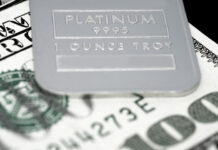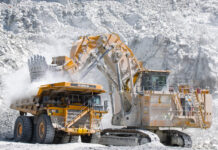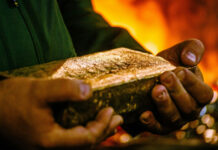
[miningmx.com] — A REPORT by Canadian stockbroker, RBC Capital Markets, made the eye-opening observation this week that Placer Dome had overstated its gold reserves by nearly a third. This was after putting gold ounces in the reserve category from the “second phase’ of its South African gold mine, South Deep, even though there was no economic mine plan to prove the gold could be extracted, it said.
It’s a fair question, according to some analysts; unfair in the eyes of others. Unfair because South Deep is a member of the great Wits Basin family, a geological expression famous for its consistency. The planning risk is not as great as a massive surface operation with more defined boundaries, analysts say.
And at 8,000 feet, the second phase of South Deep is not prohibitively deep. AngloGold Ashanti has said gold beneath 4km was probably beyond its technical and economic means, but 8,000 feet – the depth of the South Deep second phase extension – is less than 3km. “That’s do-able,’ said Muneer Ismail, an analyst for Deutsche Securities.
Analysts also believe that risk appetite for projects alters from time to time and given Placer Dome’s relatively conservative gold price assumption of $325/oz, there’s no reason why the second phase of South Deep couldn’t be developed.
“As long as a company has stated what is above or below infrastructure there shouldn’t be a problem,’ said Christian Siebert, an analyst for Citigroup. Siebert was last year critical of Harmony’s reserve statements for its Poplar and Rolspruit mine that were considered uneconomic.
“These mineral reserve statements had come under the spotlight since Harmony re-assessed its statements in the wake of its bid for Gold Fields,’ said David Davis, an analyst at Andisa Securities in Johannesburg. “Strictly speaking, you do need a plan for a reserve, but SRK (a respected South African consulting engineering company) had conducted modelling on South Deep,’ Davis said.
However, RBC Capital Markets’ analyst, Stephen Walker, was right to notice the inherent development risk of South Deep. The orebody has attracted long-term investors with an interest in the 40 to 60 year life of mine South Deep offers. In a world growing increasingly short of large gold reserves, the long-term potential of South Deep needs to be understood, not just wondered at.
Walker contends that it would cost $1.2bn in new capital over an eight-year period to develop the second phase of South Deep if it were done by its current partners, Placer Dome and Western Areas. “As such, without demonstrating the economic viability of the South Deep reserves below the existing infrastructure, we believe Placer Dome’s 2004 gold reserves are overstated by 17.8 million ounces of 29.7%,’ Walker said in a report dated July 15.
Western Areas has already shown itself troubled by the task of capital raising for the first phase. As matters currently stand, the only realistic way South Deep’s fullest extent could be mined would be through cooperation with Gold Fields, a gold firm that owns infrastructure in its Kloof mine which is less than 5km away from South Deep and deep enough to quickly access the orebody’s lower reaches. Such a cooperation has frequently been discussed but never tackled by the potential partners.
So without any realistic prospect of developing the mine tomorrow how can Placer speak of second phase reserves today?
An alteration in South Deep’s gold reserves has interesting implications for Placer Dome, according to Walker. Firstly no value is given to the second phase of South Deep because it would have negative cash flow. Secondly, Placer Dome’s adjusted market capitalisation per ounce of gold reserves increases to $155/oz against an industry benchmark of $124/oz.
Greg Martin, Placer Dome’s investor relations director, said that the company’s priority is bringing the first phase of South Deep up to nameplate capacity. Only then would the “interesting’ opportunities of cross-border cooperation with Gold Fields be considered. “As we get phase one of South Deep going, we would turn to the opportunity of joint venturing the second phase using Gold Fields infrastructure,’ Martin said.
But it will take years before that happens and in any event, Placer Dome continues to improve its understanding of the South Deep orebody. “Parts of phase two can be mined in phase one,’ Martin said. “In any event, we have engineering studies that demonstrate our long-term assumptions,’ he said.
At the end of 2004, Placer Dome estimated proven and probable gold reserves of 59.9 million ounces, down slightly from 60.5 million ounces reported at year-end 2003. About 46% of Placer Dome’s total gold reserves are contained in South Deep.
Higher grade mining news. Straight to the point. Straight to your mailbox. Subscribe now for miningmx’s free news alerts.











